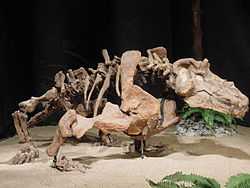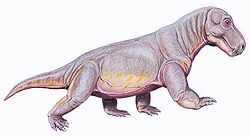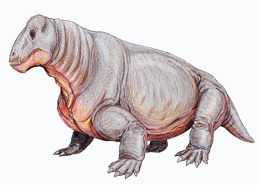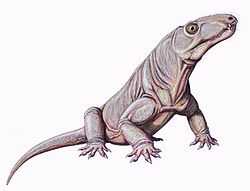Estemmenosuchus
| Estemmenosuchus Temporal range: Middle Permian, 267Ma | |
|---|---|
 | |
| E. uralensis skeleton | |
| Scientific classification | |
| Kingdom: | Animalia |
| Phylum: | Chordata |
| Clade: | Synapsida |
| Order: | Therapsida |
| Suborder: | †Dinocephalia |
| Family: | †Estemmenosuchidae |
| Genus: | †Estemmenosuchus Tchudinov, 1960 |
| Species | |
| |
| Synonyms | |
| |
Estemmenosuchus (meaning "crowned crocodile" in Greek) is a genus of large, early omnivorous therapsid. It lived during the middle part of the Middle Permian around 267 million years ago. The two species, E. uralensis and E. mirabilis, are characterised by distinctive horn-like structures, which were probably used for intra-specific display. Both species of Estemmenosuchus are from the Perm (or Cis-Urals) region of Russia. Two other estemmenosuchids, Anoplosuchus and Zopherosuchus, are now considered females of the species E. uralensis.[1] There were many complete and incomplete skeletons found together.
Description

Estemmenosuchus had a sprawling posture and could reach a body length of more than 3 m (10 ft).[2] Its skull was long and massive, up to 65 cm (26 in) in length,[2] and possessed several sets of large horns, somewhat similar to the antlers of a moose, growing upward and outward from the sides and top of the head. The animal had a sprawling posture as indicated by analysing its shoulder joints.
The skull superficially resembles that of Styracocephalus, but the "horns" are formed from different bones; in Estemmenosuchus the horns are located on the frontals and protrude upward, whereas in Styracocephalus the horns are formed by the tabular and extend aft.
Species
Estemmenosuchus lived some 267 million years ago. Two species have been identified, from the Ezhovo place near Ochyor in the Perm region of the Russia in 1960. They were found with the Biarmosuchians Eotitanosuchus olsoni and Biarmosuchus tener in channel flood deposits of the young Ural Mountains. They differ in size, shape of the skull, and shape of the horns.
Estemmenosuchus uralensis

Estemmenosuchus uralensis ("Crowned Crocodile of the Ural Mountains") grew up to 4.5 m in length with a skull length 65 cm. E. uralensis was a common estemmenosuchid in Ocher fauna.[3] It is the second most primitive therapsid after the Biarmosuchia.
The species are characterised by horns which project upward and outward on the side of the head. The mouth contained large canines with small molar teeth.
Estemmenosuchus mirabilis

Estemmenosuchus mirabilis (Wondrous Crowned Crocodile) grew up to 3 m in length with a skull length 40 cm. E. mirabilis was a fairly uncommon estemmenosuchid in Ocher fauna.[3]
Unlike E. uralensis, which had only one horn on each side of its head, this species had 2 projecting bony knobs on each side of the cranium, one on the top pointing up looking like antlers and another pointing to the side similar to E. uralensis. Its snout is smaller and wider than its relative and looks vaguely like a modern moose. The palate teeth include six incisors, two canines and about twenty small incisor-like teeth at the rear. The lower palate contained six incisors, two canines and about thirty smaller back teeth.
Paleobiology
Skin
The fossil material includes an exceptionally well preserved skin impression. The skin appears to be smooth and undifferentiated with no signs of either hairs or scales but with evidence of being well supplied with glands.[4]
Thermoregulation
It has been suggested that the animal had a fairly constant internal temperature. Its large size and compact build gave a small surface to volume rate and suggests it would not gain (or lose) temperature quickly. This phenomenon is called gigantothermy and was probably an important factor in temperature regulation in most therapsids.[5] But other scientist believe it was cold blooded, similar to today's reptiles.
Diet
As with many of the therapsids the exact diet of Estemmenosuchus is still a subject of debate amongst palaeontologists. Some have pointed to the sharp canines and incisors and declared Estemmenosuchus to be a carnivore. However many of the herbivorous tharapsids still support carnivore like teeth, and the sheer bulk and size of the body suggest that it was shaped to incorporate a large digestive system. As a general rule herbivores have larger bodies to accommodate a longer and more complex digestive system because plant matter takes longer to digest than animal meat. This is why most palaeontologists consider Estemmenosuchus to be a herbivore, although some concede that it may have supplemented its plant diet with meat and if this were true, then Estemmenosuchus would be an omnivore.[6]
Another piece of evidence to support the herbivore theory is how the legs are orientated. The rear legs are situated directly under the hips supporting the body weight from underneath. By themselves this would suggest that Estemmenosuchus spent a lot of time walking as it would provide a more energy efficient form of locomotion. The front legs however sprawl out to the sides similar to how you see them in modern lizards. While this has been suggested to improve manoeuvring so that the head ornamentation is pointed towards a rival Estemmenosuchus, or even a potential predator, a more obvious benefit is that these legs would allow Estemmenosuchus to lift its forward upper body up and down, somewhat as if it were doing push-ups. This pairing of different limb attachments would suit a herbivore better than a carnivore because it would still allow for more efficient walking when Estemmenosuchus searched for suitable food, while also allowing Estemmenosuchus to lower its head to the ground for easier low level browsing.[6]
References
- ↑ Ivakhnenko, M.F. (2000). "Estemmenosuchus and primitive theriodonts from the Late Permian". Paleontological Journal 34 (2): 184–192.
- ↑ 2.0 2.1 Ivakhnenko, M. F. (2001). "Tetrapods from the East European Placket—Late Paleozoic Natural Territorial Complex.". Proceedings of the Paleontological Institute of the Russian Academy of Sciences (in Russian) 283: 200.
- ↑ 3.0 3.1 "Therapsida: Dinocephalia: Estemmenosuchidae". Palaeos. Retrieved 13 February 2015.
- ↑ Chudinov, 1965
- ↑ Ruben, J.A.; Jones, T.D. (2000). "Selective Factors Associated with the Origin of Fur and Feathers." (PDF). Amer. Zool. 40: 585–596. doi:10.1093/icb/40.4.585.
- ↑ 6.0 6.1 "Estemmenosuchus". Prehistoric Wildlife. Retrieved 13 February 2015.
Further reading
- Chudinov, P. K. 1965, "New Facts about the Fauna of the Upper Permian of the USSR", Journal of Geology, 73:117-30
- King, Gillian M., "Anomodontia" Part 17 C, Encyclopedia of Paleoherpetology, Gutsav Fischer Verlag, Stuttgart and New York, 1988
- Olsen, E. C., 1962, Late Permian terrestrial vertebrates, USA and USSR Transactions of the American Philosophical Society, new series, 52:1–224
- Patricia Vickers-Rich and Thomas H. Rich, The Great Russian Dinosaurs, Guntar Graphics, 1993, p. 30
External links
- Palaeos - detailed description
| ||||||||||||||||||||||||||||||||||||||||||||||||||||||||||||||||||||||||||||||||||||||||||||||||||||||||||||||||||||||||||


